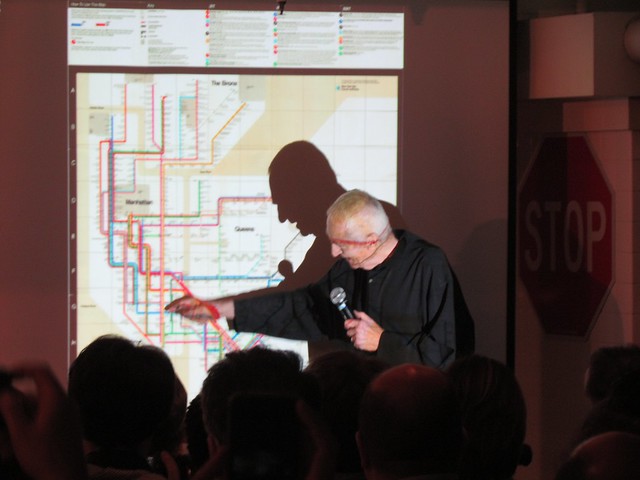It’s been just over 10 months since the MTA announced the extension of the M train into Manhattan on the weekends, and that time is finally here. The M train will now terminate at Essex/Delancey, bringing BMT Myrtle Ave. riders over the Williamsburg Bridge and to midtown-bound F trains. This is the first regular weekend service along that route since the 1950s, and the Transit Museum is running a Nostalgia Train on Saturday to celebrate.
Here’s the rest of your weekend:

From 11:45 p.m. Friday, June 6, to 5:00 a.m. Sunday, June 8, South Ferry-bound 1 trains run express from 34 St-Penn Station to Chambers St due to track tie renewal at 34 St-Penn Station.

From 11:45 p.m. Friday, June 6, to 6:30 a.m. Saturday, June 7, and from 11:45 p.m. Saturday, June 7 to 5:00 a.m. Sunday, June 8, Flatbush Av-Brooklyn-bound 2 trains run express from 34 St-Penn Station to Chambers St due to track tie renewal at 34 St-Penn Station.

From 12 noon to 5:00 p.m. Saturday, June 7, the 116 St 6 line station will be EXIT ONLY due to the 116 St Festival. Customers will not be allowed entry to this station between these hours. Use the 110 St or 125 St 6 stations instead.

From 7:00 a.m. to 9:00 p.m. Sunday, June 8, the 77 St 6 line station will be EXIT ONLY due to the Puerto Rican Day Parade. Customers will not be allowed entry to this station between these hours. Use the 68 St or 86 St 6 stations instead.

From 2:00 a.m. Saturday, June 7, to 4:30 a.m. Sunday, June 8, 7 trains are suspended between Times Square-42 St and Queensboro Plaza in both directions due to CBTC related work and track panel installation south of Queensboro Plaza. EFNQS and free shuttle buses provide alternate service. Q service is extended to Astoria Ditmars Blvd on Saturday, June 7, from 7:00 a.m. to 9:00 p.m. Shuttle buses operate between Vernon Blvd-Jackson Av and Queensboro Plaza making station stops at Queensboro Plaza, Queens Plaza, Court Square, Hunters Point Av and Vernon Blvd-Jackson Av.

From 7:00 a.m. to 9:00 p.m. Saturday, June 7, the last stop on some 7 trains headed toward Queensboro Plaza will be 74 St-Broadway due to CBTC related work and track panel installation south of Queensboro Plaza.

From 11:45 p.m. Friday, June 6, to 10:00 p.m. Saturday, June 7, Coney Island Stilwell Av-bound F trains skip Sutphin Blvd, Briarwood-Van Wyck Blvd, and 75 Av due to rail work south of Parsons Blvd.

From 11:45 p.m. Friday, June 6, to 8:00 p.m. Saturday, June 7, Jamaica-179 St-bound F trains run express between Avenue X and Jay St-MetroTech due to rail work north of Ditmars Av and signal work at Church Av.

From 11:30 p.m. Friday, June 6, to 8:00 p.m. Saturday, June 7, G trains are suspended in both directions between Church Av and Hoyt-Schermerhorns Sts due to signal work at Church Av.

From 11:45 p.m. Friday, June 6, to 9:00 p.m. Sunday, June 8, Coney Island-Stillwell Av-bound Q trains run express between Newkirk Av and Kings Hwy due to station renewal work at Parkside Av, Beverley Rd, and Cortelyou Rd.

From 7:00 a.m. to 9:00 p.m. Saturday, June 7, Q trains are extended to Astoria Ditmars Blvd due to CBTC related work and track panel installation south of Queensboro Plaza on the 7 line.
 (42 St Shuttle)
(42 St Shuttle)
From 12:01 a.m. Saturday, June 7, to 6:00 a.m. Sunday, June 8, the 42 St Shuttle operates overnight due to CBTC related work and track panel installation south of Queensboro Plaza on the 7 line.

 We’re back with an all-new episode of “The Next Stop Is…,” the only Second Ave. Sagas’ podcast around. Eric and I talked today about delays, strikes, and ferries. Oh my?
We’re back with an all-new episode of “The Next Stop Is…,” the only Second Ave. Sagas’ podcast around. Eric and I talked today about delays, strikes, and ferries. Oh my?  Toward the end of December as his days in office dwindled away, then-Mayor Michael Bloomberg rode a 7 train from Times Square into the still-unfinished station at 34th St. and 11th Ave. It was the first — and so far the only — train to make the ride, and while it wasn’t quite a ribbon-cutting, it was a valedictory ride. If all had gone according to plan, the mayor would have inaugurated the station he funded while still in office, but all did not go according to plan.
Toward the end of December as his days in office dwindled away, then-Mayor Michael Bloomberg rode a 7 train from Times Square into the still-unfinished station at 34th St. and 11th Ave. It was the first — and so far the only — train to make the ride, and while it wasn’t quite a ribbon-cutting, it was a valedictory ride. If all had gone according to plan, the mayor would have inaugurated the station he funded while still in office, but all did not go according to plan.





